

Views: 0 Author: Site Editor Publish Time: 2025-08-08 Origin: Site











You will see that a temperature test chamber can cost about $5,500 for small benchtop units. Big walk-in models can cost over $85,000. Why are the prices so different? Let’s look at the reasons:
Chamber size and capacity matter a lot. Bigger models or custom ones cost more money.
Precision is important. If you need very exact temperature or humidity control, it will cost more.
Extra features like programmable controllers or remote monitoring make the price go up.
Knowing these things helps you pick a chamber that fits your needs and budget. Want help finding the best one? Contact our team for expert advice and a special quote.
Temperature test chambers have different prices. The price depends on size, features, and how exact you need it to be. Benchtop chambers cost less money. They are good for small tests. Walk-in chambers are bigger and cost more. The main things that change the price are chamber size, temperature range, build quality, controls, and brand support. Pick only the features you really need. This helps you match your testing needs and your budget. Look up prices and compare different sellers. Think about long-term costs like energy and maintenance before you buy.
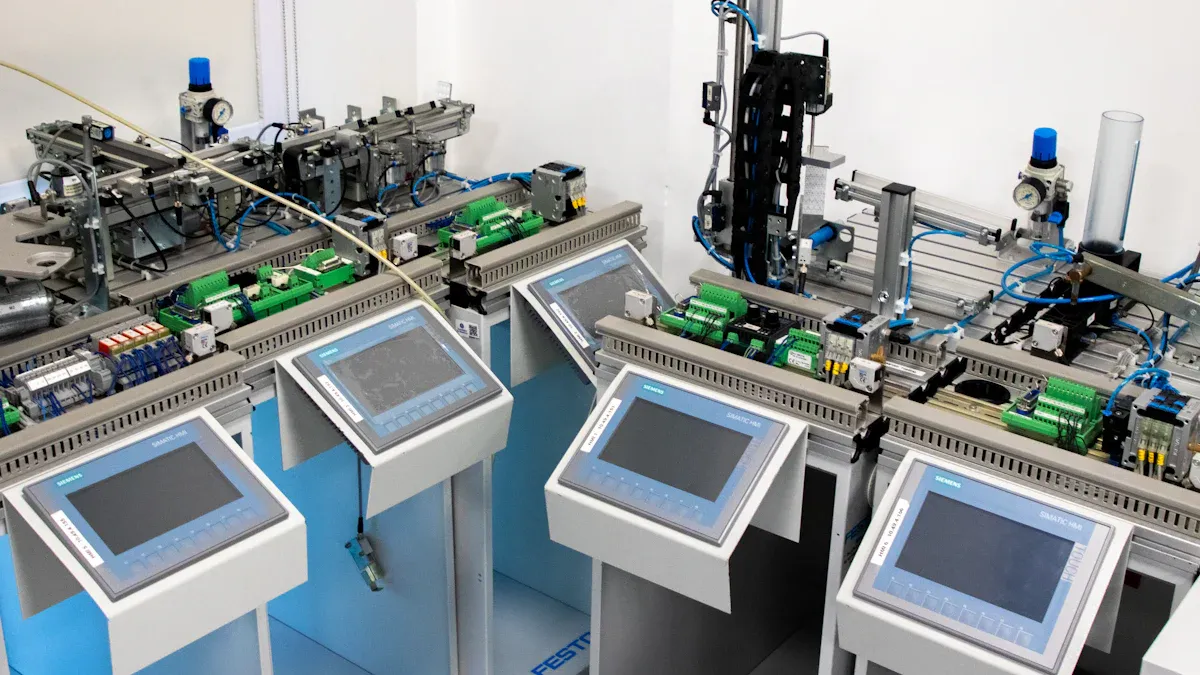
When you look for a temperature test chamber, prices are very different. Let’s talk about the main types and what you might pay.
Benchtop temperature test chambers are small and fit on a table. They are good for testing small parts or samples. These models cost between $4,950 and $19,500. The price depends on size, temperature range, and features. Here are some recent prices:
Model / Description | Temperature Range | Price (USD) |
|---|---|---|
Used SU 241 Bench-Top Chamber | -40°C to +150°C | $4,950 |
Used 105 Half Cube Table Top Chamber | N/A | $5,500 |
Used BHD-508 Chamber | N/A | $9,500 |
Used Thermal Shock Jr Benchtop Chamber | N/A | $19,500 |
Used BTRC Benchtop Temperature Humidity Chamber | N/A | $7,250 |
Used BHD-505 Chamber | N/A | $12,000 |
Used 123C Temperature Test Chamber | -68°C to 175°C | $9,500 |
Used T10C-1.5 Ultra Low Temperature Chamber | N/A | $7,500 |
Used BTRC Temperature and Humidity Chamber | N/A | $9,500 |
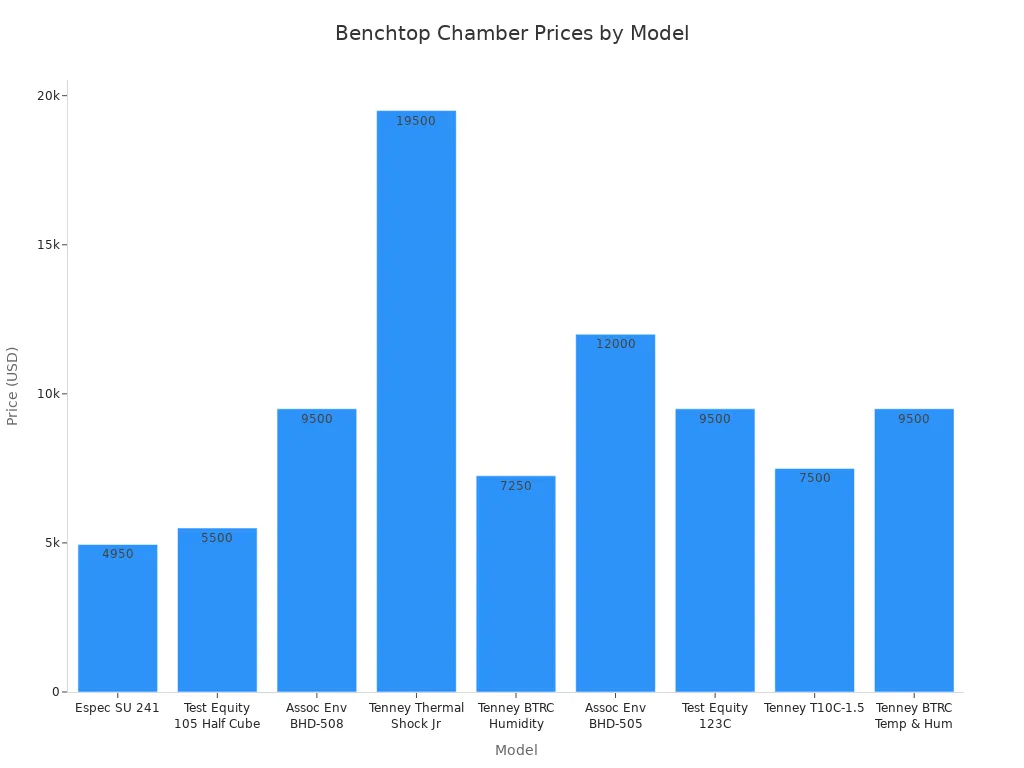
Tip: Used benchtop chambers usually cost less than new ones. You can find older models with different features and conditions. Prices change because of age, size, and features. New units have a warranty and support, which adds value but costs more.
Reach-in temperature test chambers are bigger than benchtop models. You can open the door and put larger items inside. These chambers start at about $15,000 and can go up to $31,000 or more. The price depends on size and options. Here are some current prices:
Model / Description | Purchase Price Range |
|---|---|
Standard reach-in temperature chambers | $15,000 - $20,000 |
Refurbished Benchmaster BTRC | $19,000 |
Refurbished model | $19,415 |
TC20RC2.0-A-F4T-C (with advanced controls) | $31,000 |
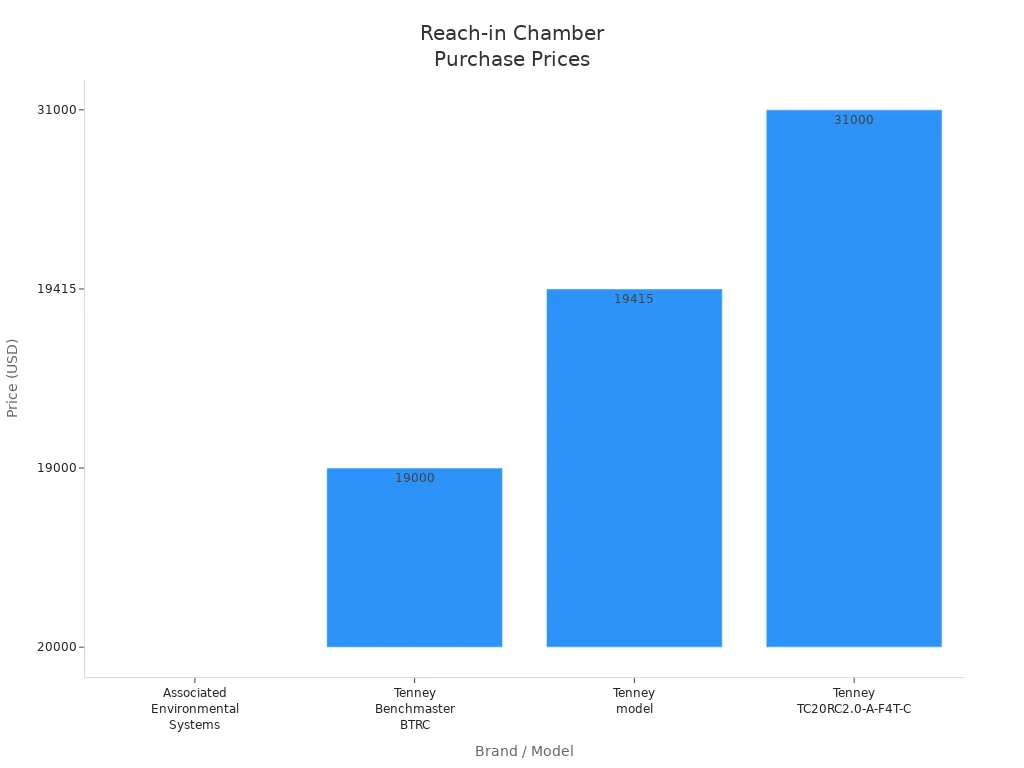
You can add things like strong shelves, extra windows, or special doors. Each upgrade makes the price higher. Optional items like advanced controllers, data loggers, or longer warranties also add to the cost.
Note: If you want a custom size or special changes, you will pay more. Extra features and services, like maintenance plans, can also make the price go up.
Walk-in temperature test chambers are much bigger. You can walk inside to test big products or many items at once. Walk-in models start at about $3,500 and can be much more, especially for large or custom chambers. Here are some starting prices:
Price Point (USD) |
|---|
$3,545 |
$3,850 |
$5,550 |
$5,850 |
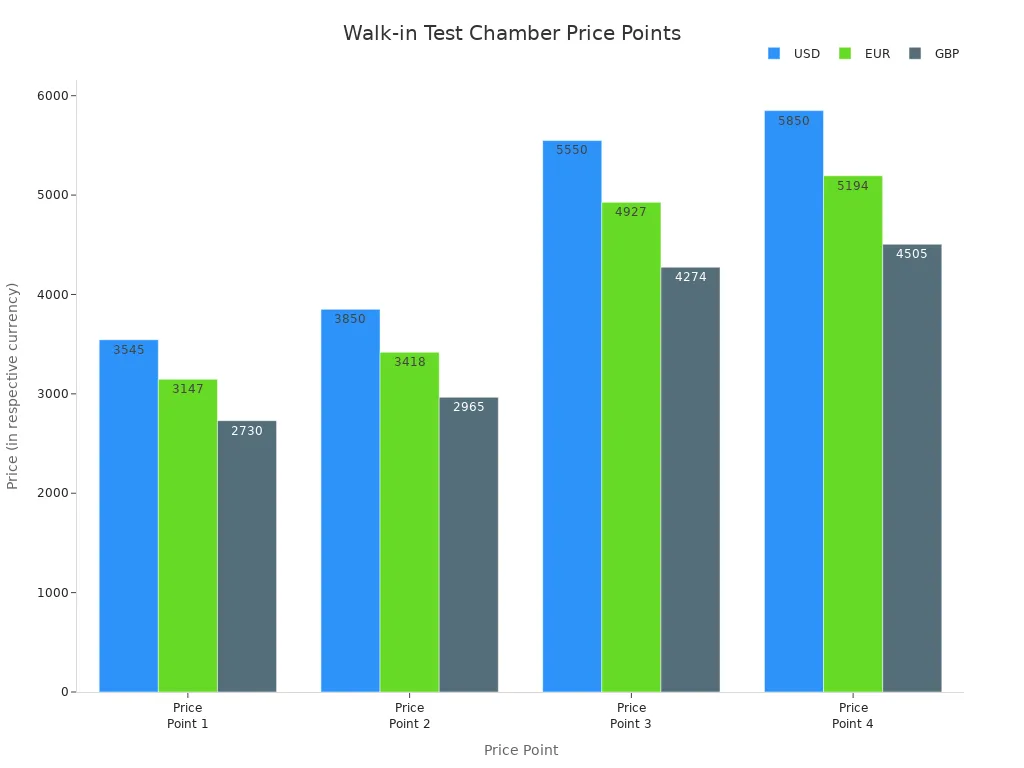
The chamber size really affects the price. Bigger chambers need more materials and more complex systems. If you need a chamber for very large items or special airflow, the price will be higher.
Tip: Walk-in chambers can be as small as a closet or as big as a room. Bigger chambers always cost more.
Specialty temperature test chambers are made for special needs. These can be for fast temperature changes, combined temperature and humidity, or special safety features. Prices for specialty chambers are often higher than standard models.
Well-known brands with good reputations usually charge more. You pay for quality, reliability, and good customer support.
Longer warranties, installation, training, and fast service can add to the price but give you peace of mind.
Specialty chambers often need more after-sales support, which can make the price higher.
Note: When you buy a specialty chamber, you also get long-term support and service. This can save you money and trouble later.
If you want help finding the right temperature test chamber for your needs and budget, our team is ready to help. Contact us for expert advice and a custom quote.
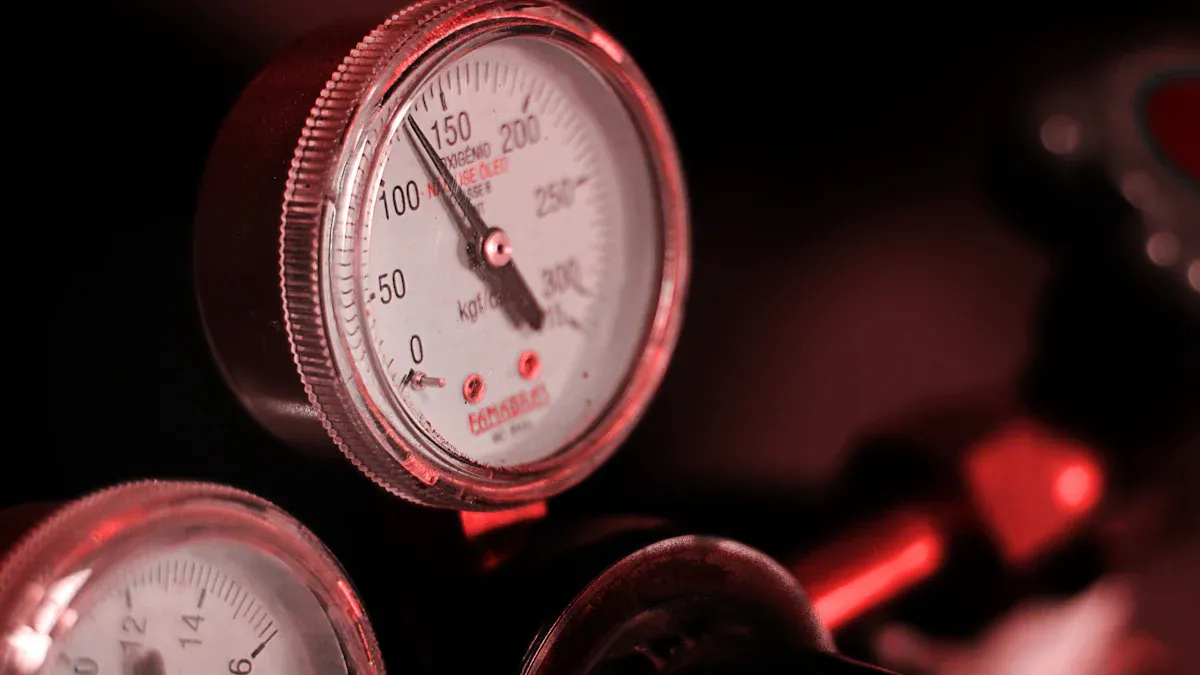
When you look at temperature test chambers, prices change a lot. There are several reasons for this.
The size of the chamber affects the price. Small benchtop chambers cost less than walk-in or drive-in models. Bigger chambers need more materials and stronger systems. They also use advanced technology. Chambers that hold a few liters are much cheaper than ones that hold hundreds or thousands of liters. For example, benchtop chambers hold about 0.9 to 5.5 cubic feet. These are good for small parts and cost less. Reach-in chambers hold 10 to 64 cubic feet. They are bigger, so they cost more. Walk-in chambers can be over 1,400 cubic feet. These are the most expensive because they use more materials and have complex systems. If you want to test big products or many items, you need a bigger chamber. This means you will pay more.
The temperature range you need changes the price. Chambers that reach very low or high temperatures cost more. If you only test at room temperature, you save money. If you need -80°C or +360°C, you need special systems. This makes the chamber cost more. A wider range means better cooling and heating systems.
Build quality is important for the price. High-quality chambers use stainless steel inside. This stops rust and keeps temperatures steady. The outside has a tough coating to protect from bumps. Good insulation, like thick foam, saves energy. Strong doors, thick glass, and safety alarms make the chamber safer. These upgrades cost more, but your chamber will last longer and work better.
Stainless steel and powder-coated steel make chambers last longer.
Good insulation and safety features keep tests accurate and people safe.
Easy maintenance and energy-saving designs help lower costs over time.
Modern chambers have smart controls and new technology. If you want exact control over temperature and humidity, you pay more. Touchscreens, remote monitoring, and data logging make chambers easier to use. These features add convenience and accuracy, but they also raise the price.
Technology Upgrade | Description | Price Impact |
|---|---|---|
Bigger fan motors | Achieve extreme temperature/humidity | Raises price a lot |
Remote monitoring | Control chamber from anywhere | Adds to cost |
Solid steel construction | Handles tough conditions | Costs more |
Advanced sensors | High accuracy for humidity and temperature | Increases price |
If you want advanced features, you will pay more at first.
You may want a chamber made just for you. Custom options like special temperature ranges or extra sensors cost more. Some buyers want programmable humidity, faster cooling, or special doors. More custom features mean a higher price. Most standard chambers cost $20,000 to $80,000. Heavy customization can make the price much higher.
Custom chambers fit your products, but cost more.
Even small changes, like extra shelves or special software, add to the price.
The brand and support you choose matter too. Famous brands often cost more because they are reliable and offer good service. Good support helps you quickly if something breaks. Extended warranties and service plans cost extra, but they help you avoid surprise bills and downtime.
Standard warranties cover parts for a set time, but not always labor or shipping.
Extended warranties and service plans give peace of mind and help control costs.
Reliable support keeps your chamber working and protects your investment.
Tip: Always ask how long the warranty lasts and what service plans include. This can save you money and trouble later.
If you want the best value for your business, contact our team. We will help you find the right temperature test chamber for your needs and budget. We will support you every step of the way.
When you look at different chambers, you notice big differences in what they can do and how much they cost. Let’s make it simple so you can choose the right one for your business.
Feature / Pricing Aspect | Entry-Level Chambers | Mid-Range Chambers | High-End Chambers |
|---|---|---|---|
Size | Smaller, often benchtop or reach-in units | Medium size, reach-in or small walk-in | Larger walk-in or specialized chambers |
Temperature Range | Limited range, typically less extreme | Broader range, moderate extremes | Extensive range, e.g., down to -70°C or up to +180°C |
Humidity Control | Often absent | Usually included | Included with advanced control |
Temperature Cycling Rate | Slower ramp rates | Moderate ramp rates | Rapid temperature cycling for accelerated testing |
Power Requirements | Lower power, e.g., 115V | Higher power, e.g., 208V | High power, e.g., 460/480V, may need external cooling |
Pricing Considerations | Lower chamber and utility costs | Moderate costs reflecting added features | Higher chamber and utility costs due to advanced specs |
Customization | Limited | Moderate | |
Additional Features | Basic functionality | Includes humidity control and better performance | Advanced features like rapid cycling, external cooling |
Entry-level chambers are good if you only need simple tests. These chambers are small and easy to use. They do not cost a lot and do not use much power. You get basic temperature control. You do not get things like humidity control or fast temperature changes. Entry-level chambers are best for easy jobs and help you save money at the start.
Mid-range chambers give you more choices. They are bigger and can handle a wider temperature range. Most have humidity control. These chambers can change temperatures faster than entry-level ones. You can also pick some extra features. They cost more, but you get better results and more ways to use them. Many people pick mid-range chambers for everyday testing.
High-end chambers have the best features. They can change temperatures very quickly and cover a wide range. They have strong humidity control. These chambers are large and may need special power. You can change almost everything to fit your needs. High-end chambers cost the most, but they are great for hard jobs and special tests.
Entry-level chambers are cheap and good for simple work.
Mid-range chambers give you more for a higher price.
High-end chambers are best for tough tests and have many features.
If you need help picking a chamber, talk to our team. We can help you look at your choices and give you a price that fits your needs.
You want a chamber that fits your tests and budget. Make a list of what you need to test. Write down the standards you must follow. Think about how big your products are. Decide how often you will use the chamber. Check if your building has enough power, water, and air flow. Look for chambers with alarms and safety systems. Compare the cost of buying a chamber to paying others to test for you. Sometimes, owning a chamber saves money over time. Plan for regular check-ups and service. Pick chambers made with strong materials like stainless steel. This helps them last longer.
Tip: Only choose features you really need. Extra features can cost more and may not help you.
Getting a good price takes some work. First, look up prices and learn about different sellers. Talk to a few sellers and compare their prices and support. Try to buy when there are sales or during slow times. Start with a lower offer so you can bargain. Use prices from other sellers to help your case. If the price cannot change, ask for free shipping or a longer warranty. Buying more than one chamber can get you a discount. Always check the quality and warranty before you buy.
Negotiation Tactic | How It Helps You Save Money |
|---|---|
Market research | Know fair prices and avoid overpaying |
Compare suppliers | Find the best deal |
Time your purchase | Get discounts during sales |
Ask for extras | Increase value without extra cost |
Bulk buying | Get volume discounts |
If you build trust with sellers, you get better deals. Do not be too pushy. Try to make both sides happy.
The price you pay at first is not the only cost. You need to think about all the costs over time. These include setup, training, repairs, energy, calibration, and downtime. Energy costs depend on how well the chamber saves power and keeps heat in. Repairs cost less if the chamber is easy to fix and made with strong parts. Good insulation and strong build mean fewer repairs and lower bills. Always check if you can get spare parts and local help.
Checklist for Buyers Before Purchase:
Does the chamber meet all the test rules you need?
Can it fit your products and handle how often you test?
Is your building ready for setup (power, water, air flow)?
Have you thought about long-term costs like energy and repairs?
Is your team trained to use and fix the chamber?
Can you make the chamber bigger or better later?
Does the seller give good help and a strong warranty?
Want help picking the right chamber? Contact our team for advice, special prices, and support at every step.
You want the best value for your investment. Focus on size, temperature range, build quality, and support when you compare options. Ask yourself these questions before you buy:
What are your exact testing needs and goals?
What temperature and humidity ranges do you require?
How many samples will you test at once, and what space do you have?
Does the chamber meet industry standards?
What are the long-term costs, including maintenance?
Use these tips to match features to your needs and budget. Ready to find the right solution? Contact us for expert guidance and a custom quote.
Think about the biggest item you need to test. Measure your samples and check how many you want to test at once. Pick a chamber that gives you enough space for airflow and easy loading.
You should clean the chamber inside and out. Check door seals and filters often. Schedule regular calibration for sensors. Good maintenance keeps your chamber working well and helps you avoid costly repairs.
Yes, you can add features like extra shelves, advanced controllers, or data logging. Some chambers let you upgrade software or add sensors. Ask us about options before you buy.
Delivery time depends on the model and custom features. Standard chambers usually arrive in a few weeks. Installation is quick if your site is ready. We help you plan every step.
Need more answers or want a custom quote? Reach out to our team today. We’re ready to help you find the perfect solution for your business.